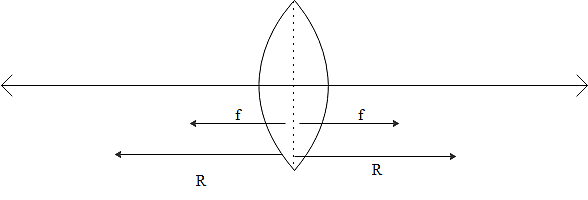
It is found that an equi-convex lens of radius of curvature $R$ is divided into two equal parts by a vertical plane. Therefore it becomes a Plano convex lens after the division. Suppose that the focal length of the equi-convex lens is given as $f$, then calculate the focal length of the Plano convex lens.
Answer
568.2k+ views
Hint: First of all draw the image of an equi-convex lens having a radius mentioned as per the question. An equi-convex lens is a lens with the two sides identical to each in the case of focal length, radius of curvature and all. This has to be kept in mind while solving the question.
Complete answer:
First of all let us take a look at the image of an equi-convex lens.

The image says that it is an equi-convex lens with a radius of curvature given as $R$. If we divide it symmetrically about its midpoint, then the equi-convex lens becomes two Plano convex lenses. As the both sides are identical in the equi-convex lens with radius of curvature as $R$ the focal length will be also the same for the two sides of the equi-convex lens. The focal length of a lens is can be expressed as the equation,
$f=\dfrac{1}{2}R$
When it is divided along the midpoint, the curved surface is not getting any kind of changes. Therefore their focal length will be the same as before. Therefore the answer for the question has arrived.
Note:
Plano-Convex lenses are useful mainly for the purpose of focusing the parallel rays of light to a single location. These kinds of lenses will be useful in order to focus, collect and collimate light. The asymmetry of such lenses will minimise the spherical aberration in some situations if the object and image are positioned at different distances from the lens.
Complete answer:
First of all let us take a look at the image of an equi-convex lens.

The image says that it is an equi-convex lens with a radius of curvature given as $R$. If we divide it symmetrically about its midpoint, then the equi-convex lens becomes two Plano convex lenses. As the both sides are identical in the equi-convex lens with radius of curvature as $R$ the focal length will be also the same for the two sides of the equi-convex lens. The focal length of a lens is can be expressed as the equation,
$f=\dfrac{1}{2}R$
When it is divided along the midpoint, the curved surface is not getting any kind of changes. Therefore their focal length will be the same as before. Therefore the answer for the question has arrived.
Note:
Plano-Convex lenses are useful mainly for the purpose of focusing the parallel rays of light to a single location. These kinds of lenses will be useful in order to focus, collect and collimate light. The asymmetry of such lenses will minimise the spherical aberration in some situations if the object and image are positioned at different distances from the lens.
Recently Updated Pages
A man running at a speed 5 ms is viewed in the side class 12 physics CBSE

The number of solutions in x in 02pi for which sqrt class 12 maths CBSE

State and explain Hardy Weinbergs Principle class 12 biology CBSE

Write any two methods of preparation of phenol Give class 12 chemistry CBSE

Which of the following statements is wrong a Amnion class 12 biology CBSE

Differentiate between action potential and resting class 12 biology CBSE

Trending doubts
What are the major means of transport Explain each class 12 social science CBSE

Which are the Top 10 Largest Countries of the World?

Draw a labelled sketch of the human eye class 12 physics CBSE

How much time does it take to bleed after eating p class 12 biology CBSE

Explain sex determination in humans with line diag class 12 biology CBSE

Explain sex determination in humans with the help of class 12 biology CBSE




